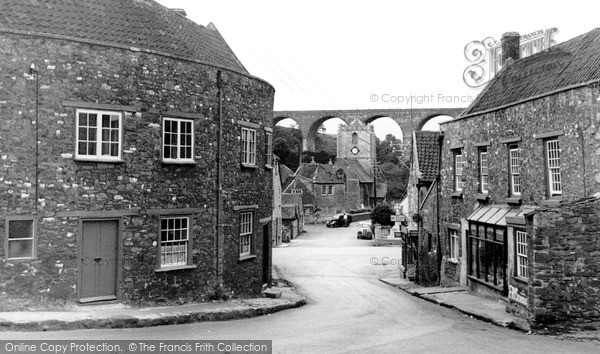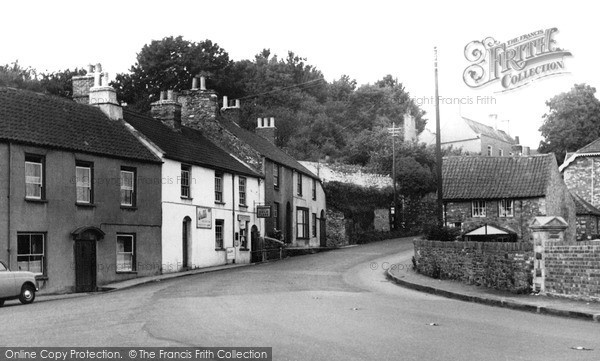The Pensford Tabernacle Connections

https://www.google.co.uk/search?q=pensford+images&rlz=1C1ARAB_enGB463GB464&tbm=isch&tbo=u&source=univ&sa=X&ved=2ahUKEwjyvJKis7XdAhWBDcAKHexTBoUQ7Al6BAgGEB8&biw=1280&bih=882#imgrc=R7HlndcvmhPuEM:
After the flood. July 1968



https://www.facebook.com/photo.php?fbid=10157617197549606&set=gm.640225056334295&type=3&ifg=1
This is a familiar and lovely image looking towards the Rising Sun, on a cold winter's day in around 1900. All the buildings on the left are gone except the distinctive 'Mousehole'. I have never really determined the exact nature of the three windowed structure on the left, other than it was a chapel of sorts - I assume Primitive Methodist - as my mother attended the 'Band of Hope' there. (See: http://spartacus-educational.com/REhope.htm
) It has a certain Quaker look about it, but the Quaker Meeting House was at Belluton until the mid 19th Century and I don't think it was ever in the village proper, although several persecuted members resided there in the 17th Century on. The two cottages at the bottom left have gone, the first to be replaced by the Miners Welfare Institute, the second demolished following the 1968 floods. The man on the left appears to be the postman - possibly my grandfather! The man on the right with horse light cab stands at the door of another house that is gone following a fire in about 1958, when sadly its occupant Mrs Barnes lost her life. The biggest change must be the road and traffic which has transformed adversely the village from silent quietude to noisy madness. This of course we put down to 'progress'.

"Tabernacles" in the 18th Century were closely connected to the followers of George White-(or Whit)-field, who preached to huge crowds in both London and Bristol. He was a west-countryman, born over a pub in Gloucester in 1714. He was one of the first (excluding the Quaker George Fox perhaps) itinerant open air preachers, often to rough and rugged miners, who it was said displayed "white rivers running down their cheeks" in response to his words. I can find no reference to him preaching in Pensford as he did in Kingswood, where his Tabernacle still exists but I am guessing the one in Pensford Hill, now no more, was the result. Its simple but dignified architecture certainly fitted the period in question.

Whitefield had a close connection with his contemporary John Wesley in a number of respects. They were both ordained in the CofE following time at Oxford and travelled to the United States, then British colony settlements, surrounded by considerable controversy around the subject of slaves amongst others of a theological nature. Whitefield in fact died there although Wesley returned amidst scandal. Of course Wesley was very fond of preaching in Pensford, visiting many times despite violent incidents, on one occasion a bull set loose into the crowd! The first Methodist Chapel was in the Barton at the bottom of the High Street, an entrance collumn still remaining, before the much more grand building in Pensford Hill (now a domestic house). Pensford has a very important place in English social history, particularly in relation to Locke and Wesley. It is something that Pensford should be aware and very proud of.

It used to be a village shop and Post Office with a small utilitarian sorting office at the rear where the four postmen used to stand glumly sorting the mail that had arrived by train in the early morning. There was also an afternoon delivery. As a small child I remember my father placing me on the bicycle rack facing him as he cycled up the hill to collect it from the snorting iron horse that steamed into the station on its way to Frome. At Christmas 1963, whilst I was still 14 I was drafted in, illegally, to join them. It was my first real paid employment, though only a pittance and my introduction to work. It was a shock to the system requiring a 5 o'clock start and a mile walk before entering their world and two shifts delivering mail and parcels on a bicycle on an eight mile round. When I set off I couldn't even see over the parcels in front of me! Unfamiliar with all the addresses it took me longer than the regular postman and I used to get stressed out being late and being reminded by the householders. I was dead beat by the end of the day after the unaccustomed early start, exertion and weather. Nevertheless it was an interesting experience entering, partially at any rate, the homes and lives of so many different people, the tiny cottages, the council estates, the farms via their long drives, the elm tree surrounded ancient homes of the gentry, echoing to the calls of the rooks in the trees. If I was lucky, the occupants offered a cup of tea or even a Christmas box of half a crown. However I wasn't sorry when Christmas Day finally arrived, I can tell you.
There is a more recent aspect to this Tabernacle theme, it was again in Pensford, adjacent to the viaduct, that in the early 1920's, a 'missionary' John Brown visited with his canvas tent on an evangelical mission that was to lead to the conversion of several people and the establishment of what was to be called 'Pensford Gospel Hall' which for maybe eighty years plus was to have an arguably positive effect particularly on a whole generation of village children. It is a sign of the times that these centres of Christian belief now struggle to continue. One of Mr Brown's specialities which drew crowds was his model and description of the original Hebrew tabernacle. It is hard now, in this post cinema, radio and TV and computer era to envisage the contribution of religion in former ages not only to faith and behaviour but also to socialisation and entertainment.

Armstrong FAWT - Pensford Church https://www.google.co.uk/search?q=pensford+images&rlz=1C1ARAB_enGB463GB464&tbm=isch&tbo=u&source=univ&sa=X&ved=2ahUKEwjyvJKis7XdAhWBDcAKHexTBoUQ7Al6BAgGEB8&biw=1280&bih=882#imgrc=xDdDTcxqa34hbM:



See also: https://veaterecosan.blogspot.com/search?q=locke
From: Steve Harries Early transactions here: https://www.facebook.com/groups/379434199080050/permalink/640225056334295/?comment_id=690383267985140¬if_id=1536781904010158¬if_t=group_comment_follow

Thanks for these references Steve which I always find interesting, particularly when they relate to identifiable plots of land with sentimental attachment. Nothing could be more so than reference to the "Old Down" which retains almost a spiritual quality, partly resulting from the fact that it was unfenced and regarded as open to all. Sadly this was abused in latter years and now is fenced and 'privatised' which has ruined the aura and public access. The second Cranston quote is familiar to me and is a delightful insight into a little domestic love tryst proposed between Atkins and Locke "at the place near the coal pits". Locke later refers to problems with these when he had inherited the estate after his father's death. I am fairly confident this was at Amercombe where my grandfather owned a plot and where my parents lived for a time, the earthworks still visible fifty years ago but since partially filled I believe. This was also the location of a murder between the workers there! I hope you don't mind me copying the above onto my blog for the record?

From: Steve Harries Early transactions here: https://www.facebook.com/groups/379434199080050/permalink/640225056334295/?comment_id=690383267985140¬if_id=1536781904010158¬if_t=group_comment_follow

Thanks for these references Steve which I always find interesting, particularly when they relate to identifiable plots of land with sentimental attachment. Nothing could be more so than reference to the "Old Down" which retains almost a spiritual quality, partly resulting from the fact that it was unfenced and regarded as open to all. Sadly this was abused in latter years and now is fenced and 'privatised' which has ruined the aura and public access. The second Cranston quote is familiar to me and is a delightful insight into a little domestic love tryst proposed between Atkins and Locke "at the place near the coal pits". Locke later refers to problems with these when he had inherited the estate after his father's death. I am fairly confident this was at Amercombe where my grandfather owned a plot and where my parents lived for a time, the earthworks still visible fifty years ago but since partially filled I believe. This was also the location of a murder between the workers there! I hope you don't mind me copying the above onto my blog for the record?





The chimney pot aerial intersects the old Methodist Chapel, Hillside House (I think) on the right, assume that's extended Travellers' Rest tdc, the Villas and what was stone masons top right, Belluton Cottages (?) top left. Are those street lights at the Chew Magna junction? I could have done with them when I used to walk home alone in the dark - always quite an eerie experience for a young lad. Yet there something is also lost when the night becomes as bright as day. In the past, after the sun set, Pensford was only lit by the escaping light from cottage windows or the temporary blaze from passing cars. The well-maintained properties give the appearance of an affluence unknown in my day, when the village was predominantly occupied by manual workers, connected by their labours above the land or beneath it, to transport, to making things or delivering them, up to and including babies. It was a society built around religion and belief, although many privately poured scorn on both. Class, occupation, location, family and belief created invisible divisions. Stanton Drew and Clutton might as well have contained different tribes on different continents. Our territories were well defined and subject to a natural ownership that others invaded at their peril. Despite the permanent presence of a policeman, crime if it existed, was officially 'petty' and people felt secure in their relative poverty. But people got along knowing they were independent yet interdependent. Travel was restricted by practicalities and the air free of aeroplanes with their noise and trails and promise of easy access to exotic foreign climes. The main road was almost a playground and House Martins still chose it as a home. The physical Pensford remains substantially the same, but beneath the tiles it is a different generation, a different society, a different milieu, weaned on modified values, different but not necessarily worse, free of many earlier fears but beset by new ones, all hidden from view.
ReplyDelete